Tech
Top 9 Blockchain Platforms to Consider in 2024

Interest in blockchain platforms has been growing significantly as a way to streamline supply chains, improve traceability, simplify trade and improve financial transactions. A lot of this interest started with the speculative frenzy surrounding Bitcoin, which is based on an older blockchain platform that faces challenges with energy consumption and speed.
Modern blockchain platforms have been developed to help overcome these limitations and provide practical value for other business uses and applications. “We are seeing multiple enterprises adopt blockchain platforms for some of their application needs,” said Suseel Menon, practice director at Everest Group, an IT advisory firm.
Menon has seen the most interest in areas that require multiparty cooperation or data exchange. Blockchain applications in supply chain tracking, trade finance, digital assets and identity management are going beyond the pilot stage. Menon has also seen a fair bit of activity in using blockchain platforms for building certain functions of ERP, such as vendor management and supply chain management (SCM).
Alex-Paul Manders, a partner at Information Services Group, an IT advisory firm, said the evolution of blockchain platforms to date has promoted heightened awareness of decentralized finance, or DeFi, for driving new business models that pose significant threats to traditional banking, finance and supply chain finance.
Alex-Paul Manders
Manders predicted that blockchain platforms could disrupt legacy supply chain businesses and technology processes. For example, U.S. requirements for pharmaceutical companies to track and trace products and materials call for a new approach for supply chain participants to share and transact data more efficiently and with more transparency than previously required. Blockchain technology could be the answer.
According to Menon, the top three blockchain frameworks for these use cases are R3 Corda, Hyperledger and Ethereum, with EOSIO and ConsenSys Quorum gaining ground.
Here are nine of the top blockchain platforms to consider.
1. Ethereum
Introduced in 2013, Ethereum is one of the oldest and most established blockchain platforms. It provides a truly decentralized blockchain that is comparable to the Bitcoin blockchain network. Manders said its key strength is that it enables true decentralization with support for smart contracts. Its key weaknesses include slow processing times and higher transaction processing costs compared to other platforms. Besides its role as a blockchain platform that underpins enterprise applications, it has its own cryptocurrency called Ether.
 Suseel Menon
Suseel Menon
The Ethereum platform has seen widespread adoption by technologists who build decentralized applications, or dApps, on the Ethereum network. For example, there are numerous platforms and exchanges for non-fungible tokens (NFTs) — a type of digital asset that can be exchanged on a blockchain. It has a mature ecosystem of tools for writing smart contracts using the Solidity programming environment, which runs on the Ethereum Virtual Machine. However, alternative blockchain networks can process transactions much faster at potentially lower cost than Ethereum, though many observers expect this to change after Ethereum adopts a more efficient security mechanism.
It also has an active developer community orchestrated by the Enterprise Ethereum Alliance, which has more than 250 members, including Intel, JPMorgan and Microsoft.
The Ethereum community migrated from a proof of work (PoW) consensus mechanism to proof of stake (PoS), which is more energy-friendly. The migration required an elaborate process to spin up a separate, new type of blockchain called a Beacon Chain that has been merged into the existing main Ethereum blockchain. The Ethereum Foundation estimated this reduces energy use by 99.95% compared to the older approach.
The community was previously considering sharding, which involved splitting up the Ethereum blockchain to expand the capacity to store data, scale throughput and cut network fees. However, new techniques for combining transactions to be processed together, called layer 2 rollups, evolved faster than expected, and sharding was dropped from the roadmap. Now the community is focusing on a simpler approach, called Proto-Danksharding, which streamlines layer 2 rollups. The goal is to eventually support up to 100,000 transactions per second using this new approach.
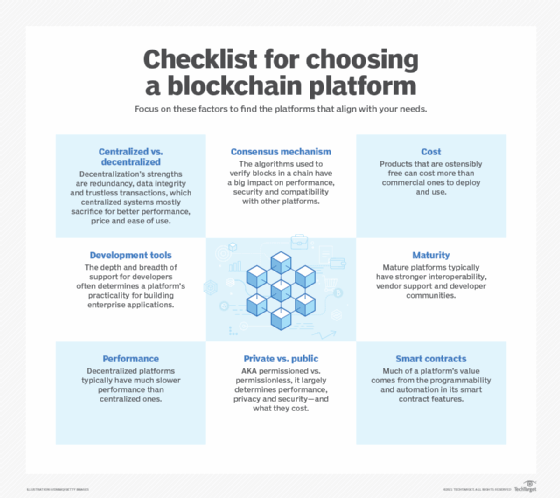
There are many things to consider when choosing a blockchain platform, including performance and cost.
2. IBM Blockchain
IBM Blockchain is a private, decentralized blockchain network that has been the most successful with enterprise clients who are less risk-averse, Manders said. He has seen the biggest opportunities in using it to link into enterprise cloud and legacy technologies more seamlessly than is possible in other decentralized networks.
The IBM Blockchain developer tool was designed to be flexible, functional and customizable. IBM has also invested in creating a user-friendly interface to simplify critical tasks, such as setting up, testing and rapidly deploying smart contracts.
Rakesh Mohan, IBM director of development, blockchain, said the company has seen significant progress in financial services and banking, as well as supply chain.
 Rakesh Mohan
Rakesh Mohan
Some examples of successful blockchain apps include IBM Food Trust, which has completed more than 18 million transactions representing more than 17,000 products, and Blockchain Community Initiative in Thailand, which supports services such as payment obligations and enterprise auctions for 22 Thai banks.
IBM Blockchain Transparent Supply is designed to help enterprises improve traceability in supply chain management. Top features support quality assurance for validating the provenance of materials, improved forecasting and tools to reduce the cost of dispute resolution, product recalls and document sharing. Various tools help manufacturing, retail, pharmaceutical and consumer goods companies jump-start their blockchain rollout.
3. Hyperledger Fabric
Hyperledger Fabric is a set of tools for creating blockchain applications. Championed by the Linux Foundation, it was built from the ground up with enterprise distributed ledger uses in mind. It has a rich ecosystem of components that can be plugged into a modular architecture. It works well in closed blockchain deployments, which can improve security and speed. It also supports an open smart contract model that can support various data models, such as account and unspent transaction output (UTXO) models.
Hyperledger Fabric can also improve data privacy by isolating transactions in channels or enabling the sharing of private data on a need-to-know basis in private data collections. It also enables high-speed transactions with low latency of finality and confirmation, according to its proponents. It is supported by leading cloud providers including Amazon Web Services, IBM, Google, Microsoft Azure and Oracle.
Arnaud Le Hors, senior technical staff member of open technologies at IBM, said the latest developments add support for an organization to join a channel without copying the whole history of the ledger. This enables a quicker startup process with less storage required. There is an active and diverse community around Hyperledger Fabric that is working on adding more features related to consensus algorithms, additional privacy options for GDPR compliance and operational improvements.
4. Hyperledger Sawtooth
Another open source blockchain initiative hosted by Hyperledger and the Linux Foundation is Hyperledger Sawtooth. One of its key advantages is that it allows enterprises to choose from several consensus mechanisms for different use cases. One novel consensus mechanism called proof of elapsed time can integrate with hardware-based security technologies to enable “trusted execution environments” of program code to run in secure enclaves, which are protected areas of computer memory. It also supports practical Byzantine fault tolerance which can allow nodes to reach consensus if hackers or other bad actors compromise some nodes. Sawtooth Raft uses a leader-based consensus algorithm that provides crash tolerance for a private and controlled group of users.
 Shawn Amundson
Shawn Amundson
Shawn Amundson, principal consultant at Bitwise IO, said the most common applications are for developing supply chain systems and customizing Sawtooth for specific purposes, such as novel consensus algorithms.
A Sawtooth library enables developers of custom distributed ledgers to pick and choose which pieces of Sawtooth they use in their application. Sawtooth also supports Splinter for networking, which provides dynamic private circuits (groups of nodes); Hyperledger Transact for transaction processing to enhance smart contract capabilities; and Augrim for consensus, which expands the number of supported algorithms.
5. R3 Corda
There is some debate whether R3 Corda is technically a blockchain or an alternative type of distributed ledger. It uses a novel consensus mechanism in which transactions are cryptographically linked but does not periodically batch multiple transactions into a block. Even the official Corda site describes it as “both a blockchain and not a blockchain.” One of the key benefits of this approach is that all transactions are processed in real time, which can improve performance compared to other types of blockchains.
The R3 consortium has a strong following in the financial industry, since Corda provides an attractive approach for financial transactions and smart contracts with strong security. Leading proponents include Bank of America, HSBC, Intel and Microsoft. It supports tools that automate business logic that can execute across company boundaries. In 2022, the group launched a technical preview of Corda Payments, which it claimed will simplify the process for building distributed payment capabilities into apps.
A recent platform update purportedly improves availability and scalability and supports interoperability with other platforms. One key innovation is a delivery-versus-payment mechanism designed to improve settlement with other distributed ledger platforms.
Manders said Corda has a strong chance of becoming the de facto network of insurance-related transaction processing. However, it faces competition from other federated blockchain networks that can process transactions faster and cheaper.
6. Tezos
In development since 2014, Tezos is an older platform that supports decentralized applications, smart contracts and novel financial instruments, such as NFTs, which can be thought of as a modern variation on trading cards that are tied to digital assets. The platform supports a dynamically upgradable protocol and modular software clients that enable it to adapt to new uses. It supports a PoS consensus mechanism that improves efficiency compared to Bitcoin and the original Ethereum implementation. An on-chain upgrade mechanism allows developers to add new features without forking, which would require spinning up a new blockchain and migrating users over. The Tezos community has been upgrading the platform at a rapid clip with enhancements that improved performance and increased the size limit on smart contracts. It has also developed tools to help automate the process of weaving NFTs into enterprise supply chains.
The latest update proposal, called the Oxford 2 protocol, promises several new enhancements. An improved PoS mechanism creates new roles for nodes. The update also reintroduces a new version of timelocks (which was previously removed), to improve security and smart rollups to speed up the transaction rate.
7. EOSIO
The EOSIO blockchain platform was first launched as an open source project in 2018. It’s optimized for developing decentralized applications and smart contracts. It uses a complex consensus mechanism based on PoS that provides better performance than older mechanisms, such as Ethereum, according to its proponents. It also includes support for a governance feature for voting on changes to the platform.
Key strengths include fast transactions and advanced account permission features for deploying applications. Over 400 applications have been developed on the platform, including identity management, SCM and gaming. The community also provides tools for customizing blockchain implementations for various decentralized use cases in SCM, healthcare and DeFi.
EOSIO-Taurus, a new blockchain released in June, was forked from the EOSIO codebase and is designed for enterprise performance on private blockchains. It includes features to handle a larger volume of transactions more securely and to improve resilience, automatic failover and disaster recovery. In addition, it could make it easier to connect the blockchain to external systems. New debugging tools are meant to improve smart contract development.
8. Stellar
Stellar is a newer blockchain platform optimized for various kinds of DeFi applications. It uses Stellar Consensus Protocol, which purportedly can speed up the time required to process and finalize transactions on a public blockchain network. It also includes security mechanisms for shutting out bad or questionable actors in a financial transaction. It has been adopted by several companies for international trade and exchanging money across borders. Examples of applications built on the Stellar blockchain include MoneyGram for money transfer, Circle for payments and treasury infrastructure, and Flutterwave for integrating payment processing into enterprise applications. The Soroban smart contract platform helps streamline development of Web 3.0 and DeFi applications on Stellar.
9. ConsenSys Quorum
Quorum is a customized version of Ethereum developed by financial services company JPMorgan. It takes advantage of the core work on the Ethereum blockchain platform and repackages it into a hardened environment suitable for banks. It has been optimized to support high-speed transactions between institutions, such as banks and insurance companies on a private network.
ConsenSys partnered with Visa to help bridge central bank digital currencies with existing payment networks and make it easier to create new services. ConsenSys also worked with Mastercard to improve rollup mechanisms that bundle multiple transactions together to improve efficiency. Quorum also adds various privacy enhancements to Ethereum to improve support for regulations such as GDPR in Europe and CCPA in California.
ConsenSys bought the Quorum platform’s intellectual property assets from JPMorgan in late 2021 and integrated them into its own work to create the ConsenSys Quorum open source protocol layer. ConsenSys has positioned the offering as a way for enterprises to accelerate development of enterprise applications that complement other Ethereum-based tools. The firm provides development services for the combined platform to enterprise customers, including JPMorgan and South African Reserve Bank. In July 2022, it launched the Quorum Blockchain Service on Microsoft Azure as a fully managed service to help simplify enterprise deployments.
The company has developed an extensive ecosystem of supporting tools and services to enhance Quorum’s value. Infura is a suite of blockchain APIs and developer tools. MetaMask is a crypto wallet and gateway to blockchain apps for end users. MetaMask Institutional helps improve workflows for compliance, data aggregation, monitoring, reporting and custody for enterprises. Diligence supports smart contract audit and security services.
Tech
Harvard Alumni, Tech Moguls, and Best-Selling Authors Drive Nearly $600 Million in Pre-Order Sales
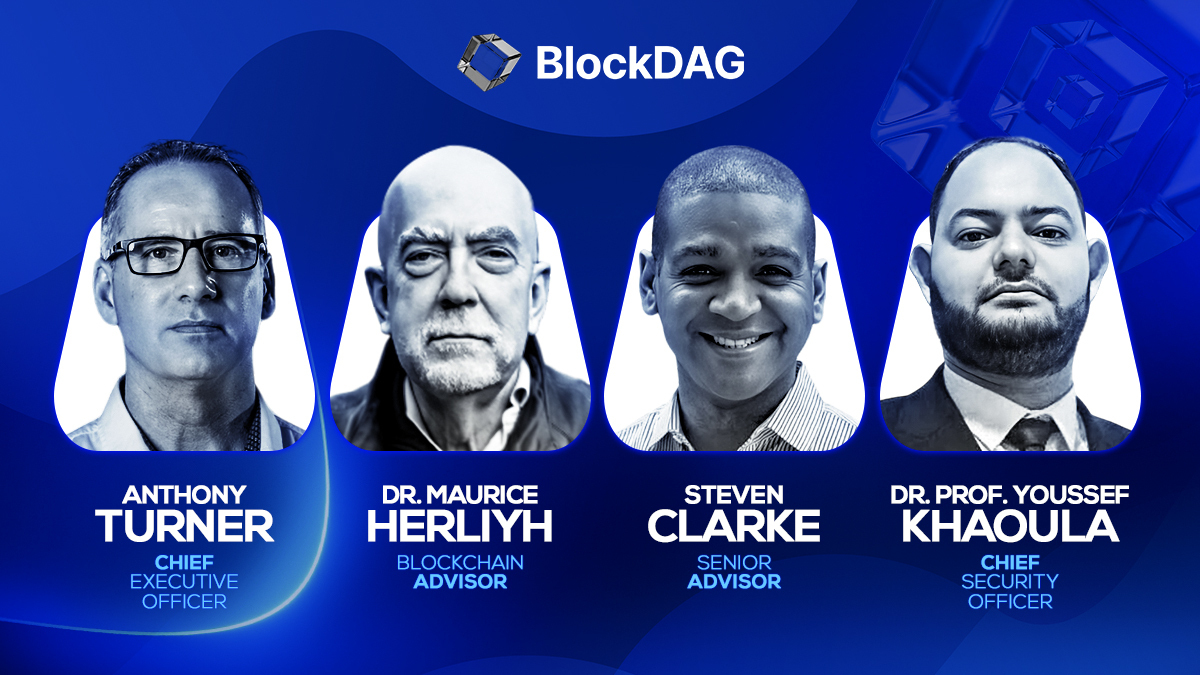
BlockDAG Network’s history is one of innovation, perseverance, and a vision to push the boundaries of blockchain technology. With Harvard alumni, tech moguls, and best-selling authors at the helm, BlockDAG is rewriting the rules of the cryptocurrency game.
CEO Antony Turner, inspired by the successes and shortcomings of Bitcoin and Ethereum, says, “BlockDAG leverages existing technology to push the boundaries of speed, security, and decentralization.” This powerhouse team has led a staggering 1,600% price increase in 20 pre-sale rounds, raising over $63.9 million. The secret? Unparalleled expertise and a bold vision for the future of blockchain.
Let’s dive into BlockDAG’s success story and find out what the future holds for this cryptocurrency.
The Origin: Why BlockDAG Was Created
In a recent interview, BlockDAG CEO Antony Turner perfectly summed up why the market needs BlockDAG’s ongoing revolution. He said:
“The creation of BlockDAG was inspired by Bitcoin and Ethereum, their successes and their shortcomings.
If you look at almost any new technology, it is very rare that the first movers remain at the forefront forever. Later incumbents have a huge advantage in entering a market where the need has been established and the technology is no longer cutting edge.
BlockDAG has done just that: our innovation is incorporating existing technology to provide a better solution, allowing us to push the boundaries of speed, security, and decentralization.”
The Present: How Far Has BlockDAG Come?
BlockDAG’s presale is setting new benchmarks in the cryptocurrency investment landscape. With a stunning 1600% price increase over 20 presale lots, it has already raised over $63.9 million in capital, having sold over 12.43 billion BDAG coins.
This impressive performance underscores the overwhelming confidence of investors in BlockDAG’s vision and leadership. The presale attracted over 20,000 individual investors, with the BlockDAG community growing exponentially by the hour.
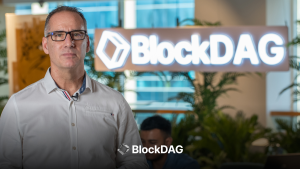
These monumental milestones have been achieved thanks to the unparalleled skills, experience and expertise of BlockDAG’s management team:
Antony Turner – Chief Executive Officer
Antony Turner, CEO of BlockDAG, has over 20 years of experience in the Fintech, EdTech, Travel and Crypto industries. He has held senior roles at SPIRIT Blockchain Capital and co-founded Axona-Analytics and SwissOne. Antony excels in financial modeling, business management and scaling growth companies, with expertise in trading, software, IoT, blockchain and cryptocurrency.
Director of Communications
Youssef Khaoulaj, CSO of BlockDAG, is a Smart Contract Auditor, Metaverse Expert, and Red Team Hacker. He ensures system security and disaster preparedness, and advises senior management on security issues.
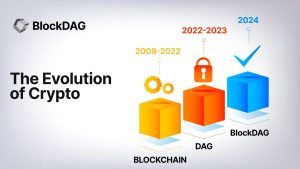
advisory Committee
Steven Clarke-Martin, a technologist and consultant, excels in enterprise technology, startups, and blockchain, with a focus on DAOs and smart contracts. Maurice Herlihy, a Harvard and MIT graduate, is an award-winning computer scientist at Brown University, with experience in distributed computing and consulting roles, most notably at Algorand.
The Future: Becoming the Cryptocurrency with the Highest Market Cap in the World
Given its impressive track record and a team of geniuses working tirelessly behind the scenes, BlockDAG is quickly approaching the $600 million pre-sale milestone. This crypto powerhouse will soon enter the top 30 cryptocurrencies by market cap.
Currently trading at $0.017 per coin, BlockDAG is expected to hit $1 million in the coming months, with the potential to hit $30 per coin by 2030. Early investors have already enjoyed a 1600% ROI by batch 21, fueling a huge amount of excitement around BlockDAG’s presale. The platform is seeing significant whale buying, and demand is so high that batch 21 is almost sold out. The upcoming batch is expected to drive prices even higher.

Invest in BlockDAG Pre-Sale Now:
Pre-sale: https://purchase.blockdag.network
Website: https://blockdag.network
Telegram: https://t.me/blockDAGnetwork
Discord: Italian: https://discord.gg/Q7BxghMVyu
No spam, no lies, just insights. You can unsubscribe at any time.
Tech
How Karak’s Latest Tech Integration Could Make Data Breaches Obsolete

- Space and Time uses zero-knowledge proofs to ensure secure and tamper-proof data processing for smart contracts and enterprises.
- The integration facilitates faster development and deployment of Distributed Secure Services (DSS) on the Karak platform.
Karak, a platform known for its strong security capabilities, is enhancing its Distributed Secure Services (DSS) by integrating Space and Time as a zero-knowledge (ZK) coprocessor. This move is intended to strengthen trustless operations across its network, especially in slashing and rewards mechanisms.
Space and Time is a verifiable processing layer that uses zero-knowledge proofs to ensure that computations on decentralized data warehouses are secure and untampered with. This system enables smart contracts, large language models (LLMs), and enterprises to process data without integrity concerns.
The integration with Karak will enable the platform to use Proof of SQL, a new ZK-proof approach developed by Space and Time, to confirm that SQL query results are accurate and have not been tampered with.
One of the key features of this integration is the enhancement of DSS on Karak. DSS are decentralized services that use re-staked assets to secure the various operations they provide, from simple utilities to complex marketplaces. The addition of Space and Time technology enables faster development and deployment of these services, especially by simplifying slashing logic, which is critical to maintaining security and trust in decentralized networks.
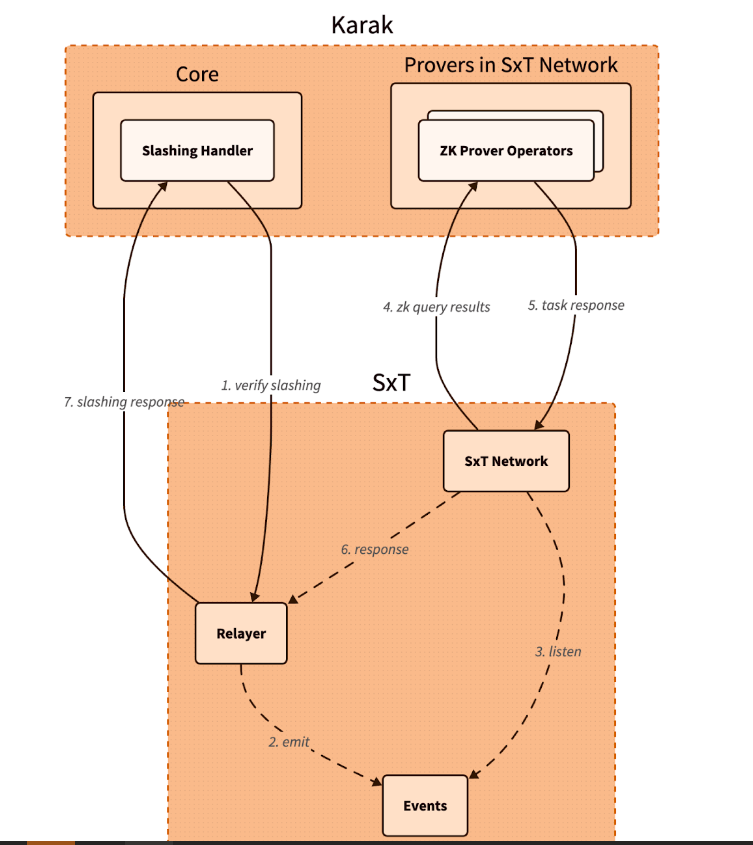
Additionally, Space and Time is developing its own DSS for blockchain data indexing. This service will allow community members to easily participate in the network by running indexing nodes. This is especially beneficial for applications that require high security and decentralization, such as decentralized data indexing.
The integration architecture follows a detailed and secure flow. When a Karak slashing contract needs to verify a SQL query, it calls the Space and Time relayer contract with the required SQL statement. This contract then emits an event with the query details, which is detected by operators in the Space and Time network.
These operators, responsible for indexing and monitoring DSS activities, validate the event and route the work to a verification operator who runs the query and generates the necessary ZK proof.
The result, along with a cryptographic commitment on the queried data, is sent to the relayer contract, which verifies and returns the data to the Karak cutter contract. This end-to-end process ensures that the data used in decision-making, such as determining penalties within the DSS, is accurate and reliable.
Karak’s mission is to provide universal security, but it also extends the capabilities of Space and Time to support multiple DSSs with their data indexing needs. As these technologies evolve, they are set to redefine the secure, decentralized computing landscape, making it more accessible and efficient for developers and enterprises alike. This integration represents a significant step towards a more secure and verifiable digital infrastructure in the blockchain space.
Website | X (Twitter) | Discord | Telegram
No spam, no lies, just insights. You can unsubscribe at any time.
Tech
Cryptocurrency Payments: Should CFOs Consider This Ferrari-Approved Trend?

Iconic Italian luxury carmaker Ferrari has announced the expansion of its cryptocurrency payment system to its European dealer network.
The move, which follows a successful launch in North America less than a year ago, raises a crucial question for CFOs across industries: Is it time to consider accepting cryptocurrency as a form of payment for your business?
Ferrari’s move isn’t an isolated one. It’s part of a broader trend of companies embracing digital assets. As of 2024, we’re seeing a growing number of companies, from tech giants to traditional retailers, accepting cryptocurrencies.
This change is determined by several factors:
- Growing mainstream adoption of cryptocurrencies
- Growing demand from tech-savvy and affluent consumers
- Potential for faster and cheaper international transactions
- Desire to project an innovative brand image
Ferrari’s approach is particularly noteworthy. They have partnered with BitPay, a leading cryptocurrency payment processor, to allow customers to purchase vehicles using Bitcoin, Ethereum, and USDC. This satisfies their tech-savvy and affluent customer base, many of whom have large digital asset holdings.
Navigating Opportunities and Challenges
Ferrari’s adoption of cryptocurrency payments illustrates several key opportunities for companies considering this move. First, it opens the door to new customer segments. By accepting cryptocurrency, Ferrari is targeting a younger, tech-savvy demographic—people who have embraced digital assets and see them as a legitimate form of value exchange. This strategy allows the company to connect with a new generation of affluent customers who may prefer to conduct high-value transactions in cryptocurrency.
Second, cryptocurrency adoption increases global reach. International payments, which can be complex and time-consuming with traditional methods, become significantly easier with cryptocurrency transactions. This can be especially beneficial for businesses that operate in multiple countries or deal with international customers, as it potentially reduces friction in cross-border transactions.
Third, accepting cryptocurrency positions a company as innovative and forward-thinking. In today’s fast-paced business environment, being seen as an early adopter of emerging technologies can significantly boost a brand’s image. Ferrari’s move sends a clear message that they are at the forefront of financial innovation, which can appeal to customers who value cutting-edge approaches.
Finally, there is the potential for cost savings. Traditional payment methods, especially for international transactions, often incur substantial fees. Cryptocurrency transactions, on the other hand, can offer lower transaction costs. For high-value purchases, such as luxury cars, these savings could be significant for both the business and the customer.
While the opportunities are enticing, accepting cryptocurrency payments also presents significant challenges that businesses must address. The most notable of these is volatility. Cryptocurrency values can fluctuate dramatically, sometimes within hours, posing potential risk to businesses that accept them as payment. Ferrari addressed this challenge by implementing a system that instantly converts cryptocurrency received into traditional fiat currencies, effectively mitigating the risk of value fluctuations.
Regulatory uncertainty is another major concern. The legal landscape surrounding cryptocurrencies is still evolving in many jurisdictions around the world. This lack of clear and consistent regulations can create compliance challenges for companies, especially those operating internationally. Companies must remain vigilant and adaptable as new laws and regulations emerge, which can be a resource-intensive process.
Implementation costs are also a significant obstacle. Integrating cryptocurrency payment systems often requires substantial investment in new technology infrastructure and extensive staff training. This can be especially challenging for small businesses or those with limited IT resources. The costs are not just financial; a significant investment of time is also required to ensure smooth implementation and operation.
Finally, security concerns loom large in the world of cryptocurrency transactions. While blockchain technology offers some security benefits, cryptocurrency transactions still require robust cybersecurity measures to protect against fraud, hacks, and other malicious activity. Businesses must invest in robust security protocols and stay up-to-date on the latest threats and protections, adding another layer of complexity and potential costs to accepting cryptocurrency payments.
Strategic Considerations for CFOs
If you’re thinking of following in Ferrari’s footsteps, here are the key factors to consider:
- Risk Assessment: Carefully evaluate potential risks to your business, including financial, regulatory, and reputational risks.
- Market Analysis: Evaluate whether your customer base is significantly interested in using cryptocurrencies for payments.
- Technology Infrastructure: Determine the costs and complexities of implementing a cryptographic payment system that integrates with existing financial processes.
- Regulatory Compliance: Ensure that cryptocurrency acceptance is in line with local regulations in all markets you operate in. Ferrari’s gradual rollout demonstrates the importance of this consideration.
- Financial Impact: Analyze how accepting cryptocurrency could impact your cash flow, accounting practices, and financial reporting.
- Partnership Evaluation: Consider partnering with established crypto payment processors to reduce risk and simplify implementation.
- Employee Training: Plan comprehensive training to ensure your team is equipped to handle cryptocurrency transactions and answer customer questions.
While Ferrari’s adoption of cryptocurrency payments is exciting, it’s important to consider this trend carefully.
A CFO’s decision to adopt cryptocurrency as a means of payment should be based on a thorough analysis of your company’s specific needs, risk tolerance, and strategic goals. Cryptocurrency payments may not be right for every business, but for some, they could provide a competitive advantage in an increasingly digital marketplace.
Remember that the landscape is rapidly evolving. Stay informed about regulatory changes, technological advancements, and changing consumer preferences. Whether you decide to accelerate your crypto engines now or wait in the pit, keeping this payment option on your radar is critical to navigating the future of business transactions.
Was this article helpful?
Yes No
Sign up to receive your daily business insights
Tech
Bitcoin Tumbles as Crypto Market Selloff Mirrors Tech Stocks’ Plunge
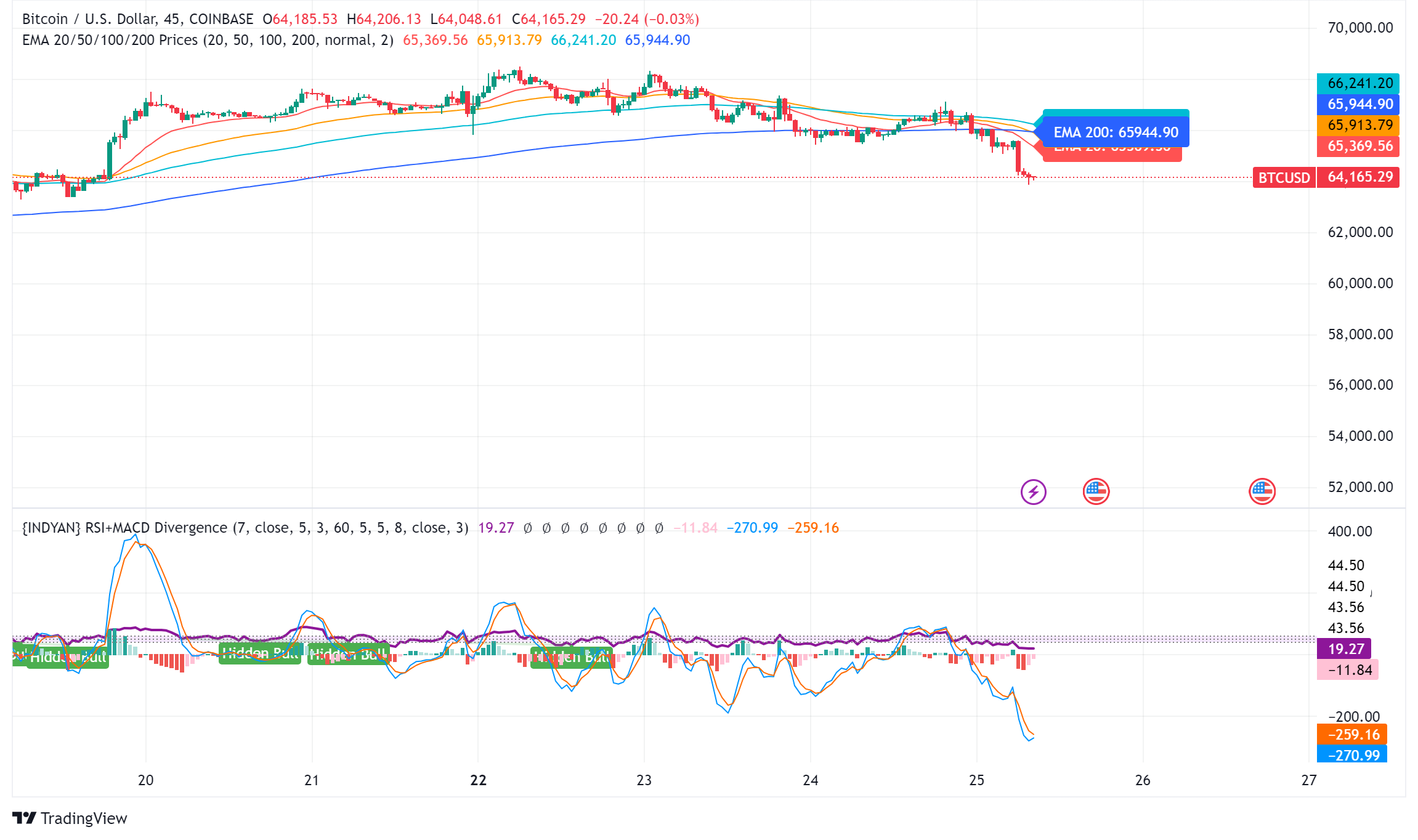
The world’s largest cryptocurrency, Bitcoin (BTC), suffered a significant price decline on Wednesday, falling below $65,000. The decline coincides with a broader market sell-off that has hit technology stocks hard.
Cryptocurrency Liquidations Hit Hard
CoinGlass data reveals a surge in long liquidations in the cryptocurrency market over the past 24 hours. These liquidations, totaling $220.7 million, represent forced selling of positions that had bet on price increases. Bitcoin itself accounted for $14.8 million in long liquidations.
Ethereum leads the decline
Ethereal (ETH), the second-largest cryptocurrency, has seen a steeper decline than Bitcoin, falling nearly 8% to trade around $3,177. This decline mirrors Bitcoin’s price action, suggesting a broader market correction.
Cryptocurrency market crash mirrors tech sector crash
The cryptocurrency market decline appears to be linked to the significant losses seen in the U.S. stock market on Wednesday. Stock market listing The index, heavily weighted toward technology stocks, posted its sharpest decline since October 2022, falling 3.65%.
Analysts cite multiple factors
Several factors may have contributed to the cryptocurrency market crash:
- Tech earnings are underwhelming: Earnings reports from tech giants like Alphabet are disappointing (Google(the parent company of), on Tuesday, triggered a sell-off in technology stocks with higher-than-expected capital expenditures that could have repercussions on the cryptocurrency market.
- Changing Political Landscape: The potential impact of the upcoming US elections and changes in Washington’s policy stance towards cryptocurrencies could influence investor sentiment.
- Ethereal ETF Hopes on the line: While bullish sentiment around a potential U.S. Ethereum ETF initially boosted the market, delays or rejections could dampen enthusiasm.
Analysts’ opinions differ
Despite the short-term losses, some analysts remain optimistic about Bitcoin’s long-term prospects. Singapore-based cryptocurrency trading firm QCP Capital believes Bitcoin could follow a similar trajectory to its post-ETF launch all-time high, with Ethereum potentially converging with its previous highs on sustained institutional interest.
Rich Dad Poor Dad Author’s Prediction
Robert Kiyosaki, author of the best-selling Rich Dad Poor Dad, predicts a potential surge in the price of Bitcoin if Donald Trump is re-elected as US president. He predicts a surge to $105,000 per coin by August 2025, fueled by a weaker dollar that is set to boost US exports.
BTC/USD Technical Outlook
Bitcoin price is currently trading below key support levels, including the $65,500 level and the 100 hourly moving average. A break below the $64,000 level could lead to further declines towards the $63,200 support zone. However, a recovery above the $65,500 level could trigger another increase in the coming sessions.
-

 News10 months ago
News10 months agoVolta Finance Limited – Director/PDMR Shareholding
-

 News10 months ago
News10 months agoModiv Industrial to release Q2 2024 financial results on August 6
-

 News10 months ago
News10 months agoApple to report third-quarter earnings as Wall Street eyes China sales
-

 News10 months ago
News10 months agoNumber of Americans filing for unemployment benefits hits highest level in a year
-

 News1 year ago
News1 year agoInventiva reports 2024 First Quarter Financial Information¹ and provides a corporate update
-

 News1 year ago
News1 year agoLeeds hospitals trust says finances are “critical” amid £110m deficit
-

 DeFi1 year ago
DeFi1 year ago🏴☠️ Pump.Fun operated by Insider Exploit
-

 Tech1 year ago
Tech1 year agoBitcoin’s Correlation With Tech Stocks Is At Its Highest Since August 2023: Bloomberg ⋆ ZyCrypto
-

 Tech1 year ago
Tech1 year agoEverything you need to know
-

 Markets12 months ago
Markets12 months ago20 Top Crypto Trading Platforms to Know
-

 News10 months ago
News10 months agoStocks wobble as Fed delivers and Meta bounces
-

 Markets1 year ago
Markets1 year agoWhale Investments in Bitcoin Hit $100 Billion in 2024, Fueling Insane Investor Optimism ⋆ ZyCrypto





